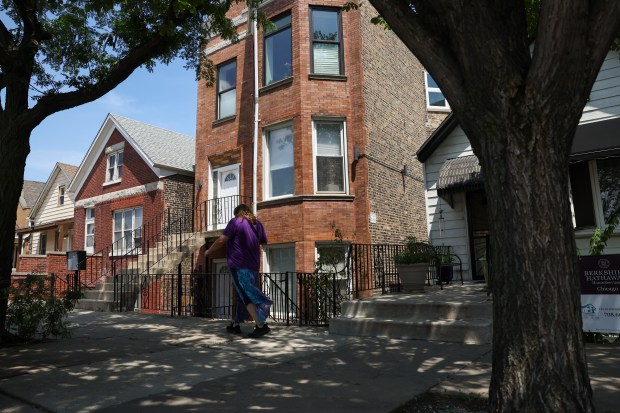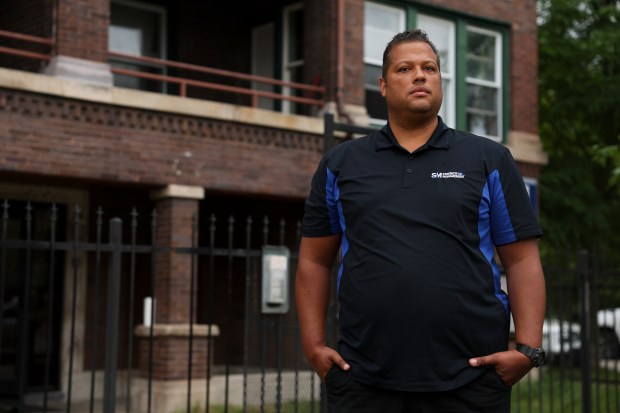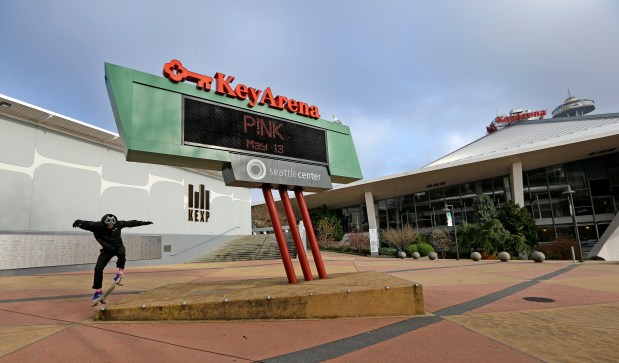Stuart Handler runs a company that owns and manages 47 properties, with a total of 6,000 apartments throughout the Chicago area. For 2024, the insurance premium on his portfolio of properties increased about 150%, and his deductible climbed from $100,000 to $1 million.
The jump in insurance costs came even though Handler’s record of filing claims related to damage at his properties — an action which can cause rates to increase — has been “extremely low” over the past 10 years, he said.
“We are in a crisis mode with insurance,” said Handler, who is CEO of TLC Management and declined to share the dollar amount by which his premium increased. “It used to be that insurance was a stable, inconsequential line item on an expense summary for a management company. Now, it has become so large, it is having an impact on … affordability and will lead to higher rents.”
Rents for some of Handler’s units have increased as much as 20%, while other rents have stayed the same or declined as much as 10%. His firm sets prices using a rent optimization tool — one created by Yardi Systems, a company facing a class-action antitrust lawsuit for allegedly conspiring to fix rent prices with the tool.
Although Handler’s heard from his provider that his insurance costs won’t increase in 2025, he’s one of numerous housing providers speaking out about skyrocketing insurance premiums and the need to raise rents because of them.
Most publicly available data on insurance rate increases focuses on homeowners’ insurance policies, and not the premiums that owners of multifamily buildings pay. But insurance experts say many rental building owners have seen their insurance costs increase 10% to 20% in recent months and years, and property owners interviewed by the Tribune reported increases ranging from 11% to 150% between 2023 and 2024.
Insurance groups acknowledge having to boost prices, saying it is necessary to cover rising expenses tied to the greater volume of climate-change-induced natural catastrophes and high building and reinsurance costs. And while housing providers want recourse, the Illinois Department of Insurance’s hands are tied as insurers raise rates, because it does not have the authority to approve or reject rate changes, unlike many other states.
Some in the real estate and insurance industries are calling for more regulation of Illinois’ insurance market.
But the American Property Casualty Insurance Association, a trade group representing insurance providers, said increased regulation would do more harm than good.
“Having the insurance regulator approve your rates really impedes the ability of the insurance industry to charge a rate that is actuarially sound or reflective of underlying risk,” said Eric Goldberg, department vice president and counsel in the trade group’s commercial division. “That becomes especially challenging in an inflationary environment where the costs of material and labor are going up, but you can’t be nimble enough to change those prices to reflect those increased costs.”
Greater risks, rising costs
While Illinois does not have California’s wildfires or Florida’s hurricanes, insurance companies are raising rates everywhere due to greater climate risks, construction costs and an overall increase in liability claims. Some housing providers and insurance experts say multifamily rates are in line with or above the double-digit increases seen for homeowners insurance.
Corey Oliver, CEO of Strength in Management, a property management company that owns and operates around 500 affordable housing units on the South and West sides, said that with insurance costs rising as substantially as they are — some owners are seeing their insurance rates double — it makes profitability and sustainability for building owners “very difficult.”
Oliver said one of his properties, a 12-unit building in Englewood, saw its premium go from around $7,000 to nearly $13,000 between 2023 and 2024.
Because of increased building costs such as insurance, some owners are upping their rents $100 a month — although not every year and not enough to cover the increased costs, Oliver said.
“We have some tenants where we haven’t raised rents in three to four years, and now they have gotten two years, back-to-back rent increases,” Oliver said. “It’s terrible.”
Like others who spoke with the Tribune, Goldberg cited rising building costs, an increase in catastrophic weather events and greater attorney involvement in insurance claims as some of the reasons for rate hikes in Illinois and beyond. The rising cost of reinsurance, the insurance that insurance companies purchase, is also a factor.
Illinois auto and home insurance rates keep rising as Allstate, State Farm plan double-digit hikes
One developer recently experienced firsthand the higher insurance costs associated with greater climate risks.
Jonathan F.P. Rose, president of his eponymous company, which develops environmentally conscious affordable and mixed-income housing in Chicago and nationally, said his insurance costs recently went up after he filed an insurance claim for a burst pipe at his then newly acquired property in Grand Boulevard at the end of 2022. Had he purchased the building earlier and taken it through a “greening process” that would have involved insulating the pipes, his insurance costs wouldn’t have gone up as much, Rose said.
Rose, who spoke at a recent U.S. Department of Housing and Urban Development summit on rising property insurance costs, told the Tribune that the insurance rate for his national portfolio — 19,000 units across 20 cities — went up about 11% between 2023 and 2024, an increase he called “modest” compared with others seen in the industry. He attributes his more modest increases to building greener properties that are less prone to crumble when disaster strikes.
“The greening strategies (are) right for the environment, but they are also really right for insurance costs,” Rose said.
Illinois-based Allstate and State Farm, two large insurance providers in the state and nationally, declined to provide specific rate hike information requested by the Tribune. While homeowners insurance rate increase information is publicly available in the state, data for commercial properties — specifically, multiunit residential buildings — are not accessible in the same way.
In a response to a Tribune request for comment on double-digit multifamily rate hikes in the past few years, State Farm said its rate changes are driven by increased costs and risk.
“It is important to note that many factors are considered when underwriting and pricing an insurance policy,” State Farm said. “We review loss trends over a period of years when determining rates. Our rates are based on the need to pay anticipated future claims informed by actual claims experience in an area — from weather, hail, wind, water, fire, accidents, liability, theft, and so on.”
Allstate did not respond to a similar question from the Tribune.
A spokesperson for Ohio-based Nationwide, another large insurance provider, said in an email that the company is taking steps to address the challenges in the market and “ensure long-term viability,” like others in the industry.
“Inflation and market disruptions impact insurance just like they do any other business. In many instances, this means we are updating our rates,” the statement said.
Nationwide did not specify its exact rate hikes and did not respond to further questions about its rates.
Some insurance providers ]deferred to the Insurance Information Institute — an organization that focuses on analyzing various types of insurance, but not insurance for apartment building owners specifically.
Alexandra Glickman, a global practice leader for real estate and hospitality at Chicago-based Gallagher, one of the largest global insurance brokerages, said a dual surge in liability- and property-related costs is leading to a 15% to 20% average national increase in insurance rates for many apartment building owners in the last two quarters.
Liability costs are incidents such as legal claims by tenants against their landlords, with Illinois being a particularly tenant-friendly jurisdiction, Glickman said. Property costs are incidents related to weather events such as the hailstorms and polar vortexes that have become more common in the Midwest, she said.
On top of the rising costs, there is more demand for insurance than supply. Housing providers and insurance experts like Glickman said it is becoming more challenging to find insurance coverage, as companies are pulling out of the risky market.
Miguel Chacon, a housing provider in Pilsen and a real estate broker, said that last year, for the first time in his 20 years as a building owner, he made an insurance claim on one of his properties. The insurance provider dropped the policy when it came time to renew, Chacon said.
Chacon is also seeing his insurance rates double. For a three-flat he and his wife purchased and lived in during the early 2000s, Chacon’s insurance policy went from $2,177 in 2023 to $4,575 in 2024.
Because of increased costs, including in his property tax bills, Chacon raised rents $75 for each of the units in the three-flat, a roughly 4% to 5% hike.

Allstate and State Farm say they are continuing to issue new insurance policies in Illinois. A Nationwide spokesperson said it continues to write policies in Illinois as well, although “we are being more selective around the amount of overall risk we are willing to write.”
Glickman, of Gallagher, said there will always be insurance, but “the kicker is: How much is it going to cost?”
“Multifamily is, I would argue, the most difficult of all the asset classes because it has so many different avenues for losses,” Glickman said.
Illinois lacking in regulation
Local owners and managers such as Handler and Oliver are calling for more awareness and oversight, respectively, of Illinois’ insurance industry.
The National Association of Insurance Commissioners has a model law for state property and casualty insurance regulations that includes language such as “Rates shall not be excessive, inadequate or unfairly discriminatory.”
Most states adopted this language in the wake of the McCarran-Ferguson Act — the 1945 federal statute giving states control of the regulation of the insurance industry — and, in turn, have been better able to regulate insurance costs, according to Doug Heller, director of insurance for the Consumer Federation of America.
But Illinois does not have this language on the books for property and casualty insurance.
Illinois is a largely deregulated insurance market, having “no meaningful oversight,” unlike most states around the country, Heller said.
“What people are seeing is part of what I think has to be described as a looming crisis, if not already a crisis, for our housing system,” Heller said. “… It’s not that it is working perfectly throughout the country (beyond Illinois). … But if you don’t even have the tools, you don’t even have the chance to use them well.”
The Illinois Department of Insurance declined to make someone available for an interview.
In a statement, a spokesperson said the department does not have the regulatory authority to set property and casualty insurance rates, including homeowners and commercial property insurance. While some states, such as California, have the ability to review and approve insurance rate increases, Illinois requires only that rates be filed with the department.
“The Department stands ready to partner with consumer advocates and legislators to increase consumer protections and enhance the Department’s regulatory authority regarding homeowners insurance rates in Illinois,” the statement said.
State Rep. Thaddeus Jones of Calumet City and state Sen. Napoleon Harris of Harvey, the Democratic chairs of the legislature’s Insurance Committees, did not respond to requests for comment. State Rep. Bob Morgan, a Democrat from Deerfield and vice chair of the House Insurance Committee, and state Sen. Sara Feigenholtz, a Democrat from Chicago and another member of the Senate Insurance Committee, declined to comment.
State Sen. Dave Syverson of Rockford, the Republican spokesperson for the Senate Insurance Committee, said Illinois’ insurance prices were lower compared with other states until the last few years, thanks in part to Illinois’ lack of regulation and, in turn, an abundance of providers offering insurance in the state, which allows there to be competition in the market. He thinks inflation has to be controlled in order to mitigate swelling insurance costs.
“Having the state try to regulate rates is not going to affect what’s happened with those costs,” Syverson said. “What it will do, like it has done in some other states, is drive insurance companies out of the state.”
Goldberg, of the insurance trade association, said Illinois’ unique lack of approval for insurance rates is good for the market. Like Syverson, he said that if more regulation comes to Illinois, the natural response to insurers would be to pull back.
“If (regulators) allow insurers to charge what needs to be charged to cover the risk and make a reasonable rate of return, more investors are probably going to be willing to put some money into that state,” Goldberg said.
But some Illinois owners are already being forced to sell their properties because of rising costs such as insurance, said Oliver, of Strength in Management.
“We’re losing local Chicago operators, and we’re losing minority owners who can no longer own and operate buildings in their own communities because of these crazy, unsubstantiated cost increases,” Oliver said.




